Patchwork pillows

Modern interior design is multifaceted. A sea of ideas, a flight of imagination allow you to fit the most unusual objects into the style. However, no matter how generous the store assortment is, a handmade product is always unique and is the highlight of the style. Take, for example, accessories such as Patchwork-style pillows: a technique that has gone around the world and has a lot of techniques, has been known for a long time, today it is in the spotlight.
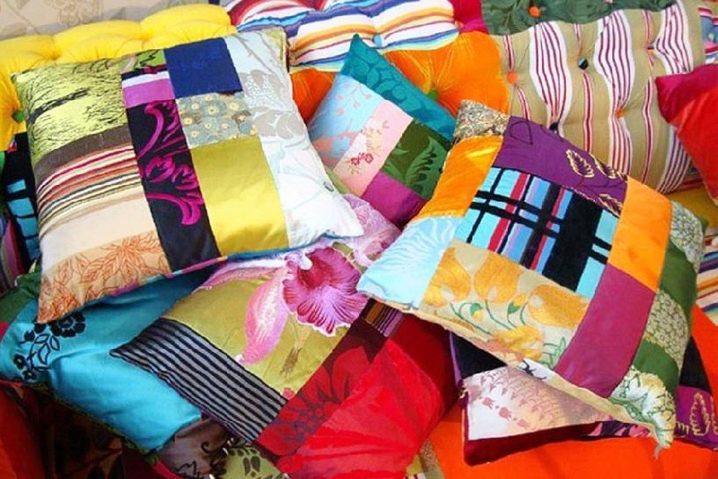
Features, pros and cons
Pillows in the style of "Patchwork" or, more simply, "patchwork" pillows - decorative accessories made of patches of different shapes and sizes, scraps of different fabrics. This is painstaking work to create a product with a specific pattern of varying degrees of complexity. The technique is old, its appearance was associated with a shortage of textiles, so every patch was of value in the work.
Over time, the chaotic selection of flaps was replaced by the correct layout, taking into account the color scheme and a specific theme. Today, special attention is paid to handicrafts, so in stores you can buy not only ready-made sets in the same style, but also "correct" blanks, whether they are individual square elements or ready-made sets with cut fragments.
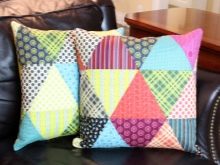


Patch pillows have many advantages:
- can dictate a design idea or be a support for a certain interior item;
- are self-sufficient accents or are completed with a bedspread, rug, blanket, upholstered furniture capes;
- are made on a sewing machine, therefore they are tear-resistant and durable;
- can be located anywhere in the room, decorating the surface of furniture (sofa, armchairs, chairs, stool) or window sills;
- have a wide range of sizes and shape variability;
- are distinguished by a variety of carved fragments and a rich choice of color palette;
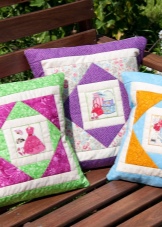

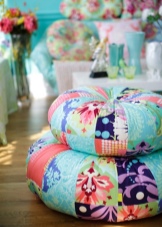
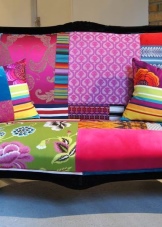
- look professional and bright, obeying the rules for selecting the texture of the material;
- are made from textiles of natural and synthetic origin;
- are divided into several techniques for performing the drawing, gathering according to a previously prepared scheme;
- are made in the form of full-fledged pillows or as decorative pillowcases for the sizes of existing dummies, taking into account the ease of maintenance (they can have a zipper or buttons with loops);
- can combine different needlework techniques (for example, classics and Japanese "patchwork" kinusaiga, iris folding, etc.);


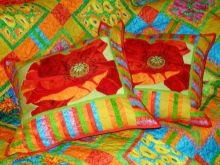
- are a favorite topic of needlework for experienced craftswomen and inspire beginners to work;
- recognized as an excellent gift for yourself or loved ones for a celebration;
- not capricious in care, machine washable at 40 degrees, easy spin and dry naturally;
- depending on the pattern and color scheme, they are able to create a visual illusion of an increase in the space of the room;
- create a sense of home comfort by maintaining a welcoming atmosphere or by zoning a specific part of the room.

Patchwork pillows can be functional household items (for example, transformer models in the form of bedding covers, pajamas). According to the production method, they can be one-sided with a pattern on one side, double-sided, decorated with the same or different pattern on both sides.
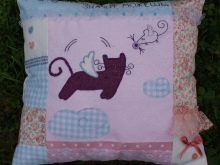
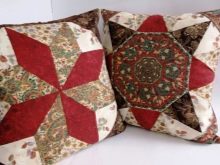
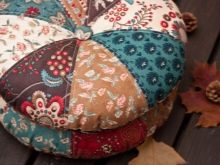
With a lot of advantages, patchwork cushions have several nuances:
- require a lot of free time to make a quality product;
- look professional only with patience, accuracy and accuracy (assembly errors of each element are unacceptable);
- look beautiful, having a pattern, without it they create a feeling of variegation and overload of design;
- due to the creation of separate fragments, they need a mandatory gasket that covers the surface of the connected parts from the seamy side;
- "Marketable" look from new materials, purchased especially for needlework.
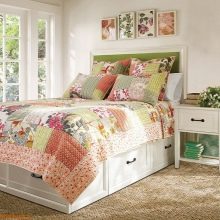

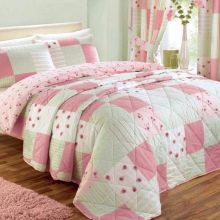
The cost of such things usually cannot be called budgetary. As a rule, professional craftswomen have their own rate, which is based on the hourly rate, so buying a set of several pillows and, say, a blanket can be expensive. However, in most cases this is not an obstacle to acquisition, since there are many connoisseurs of such art, and they are ready to do much to decorate their interior with exclusive novelties.
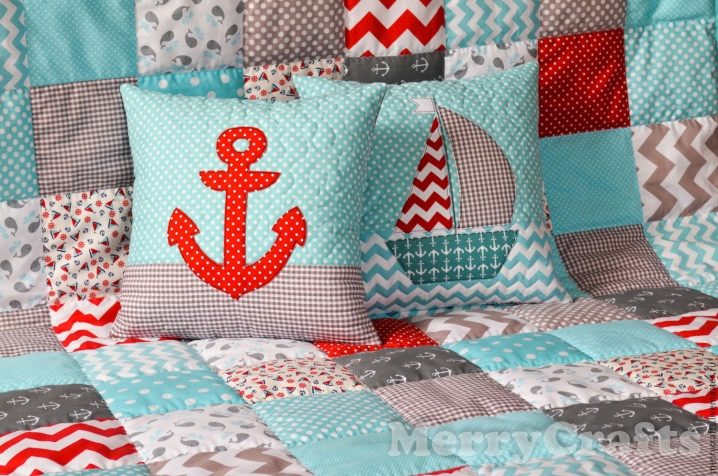
Materials and color
Due to the wide range of fabrics and materials, different raw materials are used in the production of decorative cushions. These are mainly cotton textiles (chintz, satin, poplin, twill). The weave density can be sparse or frequent. As a rule, they try to use opaque fabrics for work. The most successful textile option is a fabric with a plain weave of threads, although fabrics with a twill fabric structure are often used in production.
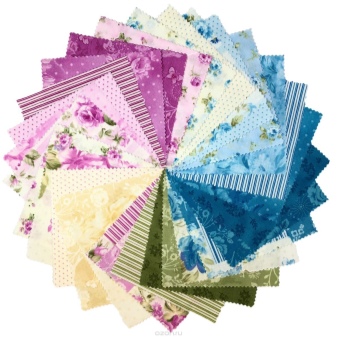
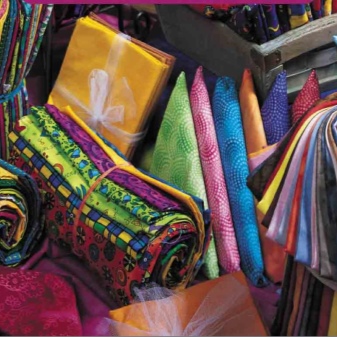
In volumetric and textured models, a material with mixed fibers or a fully synthetic material (acrylic, polyester) is used. Sometimes quite dense raw materials are used: denim or even artificial leather. However, the use of such materials forces us to simplify the pattern of the pillow, so dense models consist of squares.
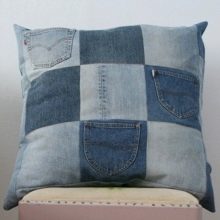

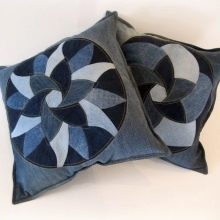
The times when all scraps were used indiscriminately are a thing of the past. Today the color scheme is one of the basic principles of work. Usually a set of colors does not exceed 10 different shades, although experienced craftswomen with a sense of style successfully add additional contrasts to the colors. The colors of the patchwork cushions are varied. Today, the focus is on the main background, complemented by a thematic pattern.


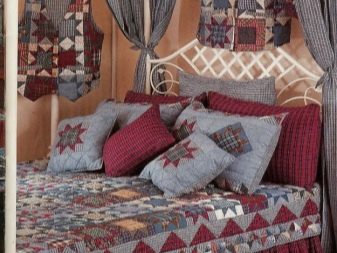
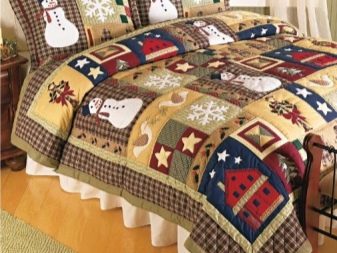
The base can be light or dark, but does not interrupt the idea.
Pattern types
Modern patchwork has been brought to perfection, sometimes representing real masterpieces of needlework. The basics that give rise to creative intent include:
- Classic square - the simplest way, which involves connecting squares of a certain size, often not obeying any pattern (a great way to pick up the remnants of fabric);

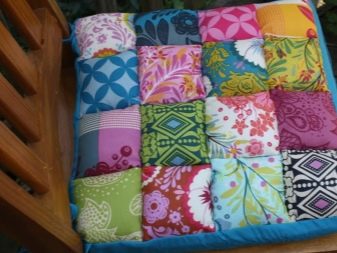
- Square in square - a classic technique, when the pattern starts from the central square, along the edges of each side of which smooth triangular fragments with an angle of 90 degrees from the same material are grinded;

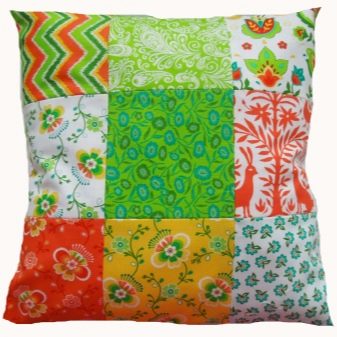
- American square - the original version of the pillow made of squares with a slight difference: each piece of a square shape to increase the size is complemented by a rectangular strip along the side edge, gradually increasing in size;
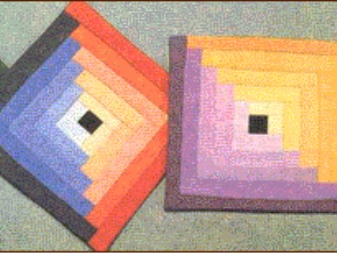

- Triangle - simple and complex combinations of rectangular and acute-angled fragments, complemented to a square by blanks of the required size, connected in pairs (they can make patterns in the form of contrasting squares);
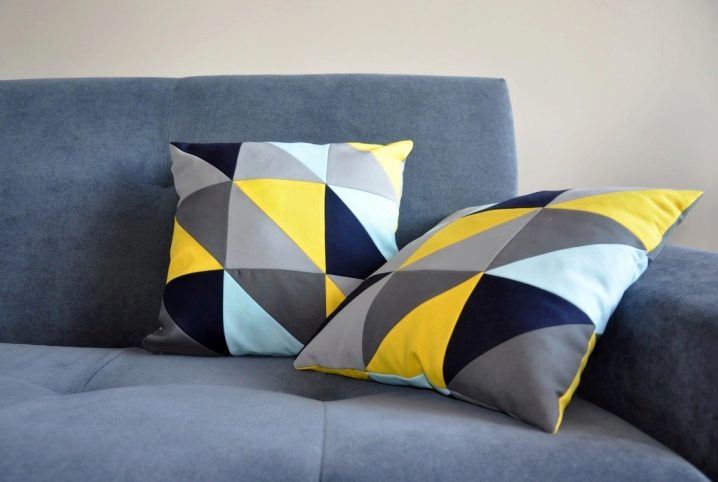
- Dresden plate - a flower in the center, enclosed in square frames or without them, created with a round center and elongated petals, may have additional decorative stitches in the four corners;
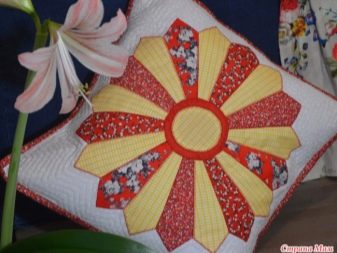
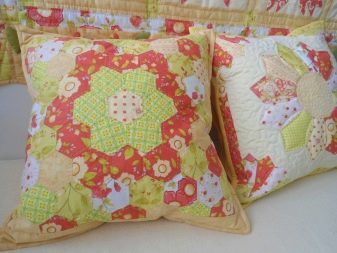
- Chrysanthemum petals - technique in the spirit of "iris folding", in which the flaps are folded in half and fixed, overlapping one on top of the other, about 1-2 cm (volumetric options for pillows of regular and round shape);
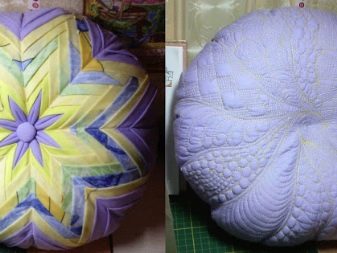
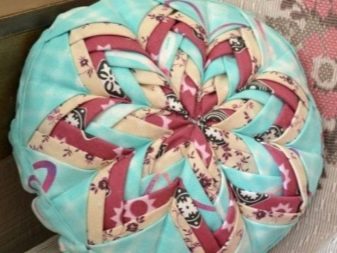
- Mill - a drawing resembling a classic turntable, created from right-angled triangles or their combination with squares with coincidence of sides;
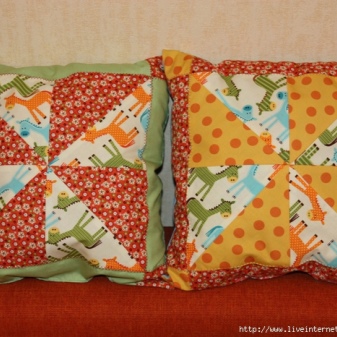
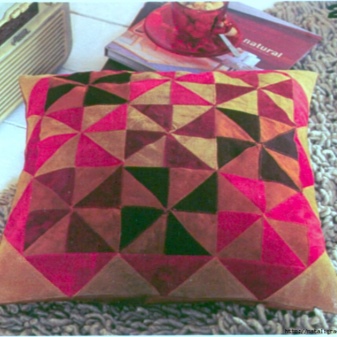
- Crazy - a base of an unusual shape (for example, pentagonal and stripes), increasing in size due to rectangular stripes sewn to the side edges;
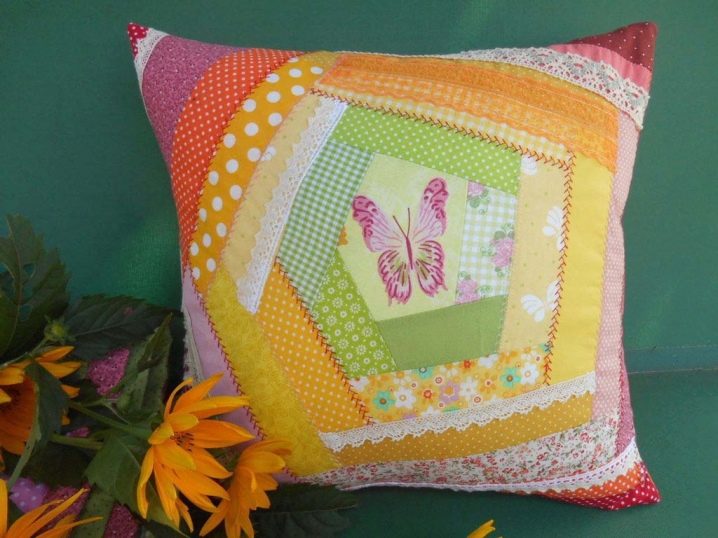
- Japanese method - handicraft with a needle-forward seam, mainly of silk fabric with the addition of embroidery.

The uniqueness of the patterns is the ability to use textiles with a ready-made small pattern. Usually it becomes a central decoration, complemented by contrasting motifs on all sides, creating a multi-layered effect.
The main types of patchwork prints are:
- small cell;
- two-tone stripe;
- classic polka dots;
- floral and plant ornaments;
- children's funny animals;
- cartoon characters;
- African, Indian, ethnic motives;
- geometry and abstraction.
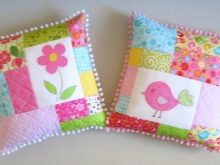
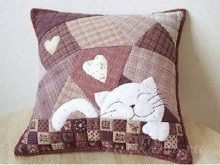
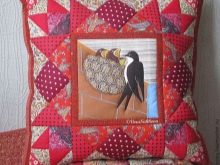
For better compatibility, the shades of the color palette of the patches echo each other. A good solution is considered to be a technique in which fragments from identical material do not merge together.
Shape, ideas, decor of a sofa cushion from patches
The range of decorative pillows is diverse. The main part of the ruler is made in the form of a square, often the products are a circle, an oval, a roller, like a round pouf, supplemented for greater texture with a button in the center. Such models are unique and today are no less popular than their classic counterparts.
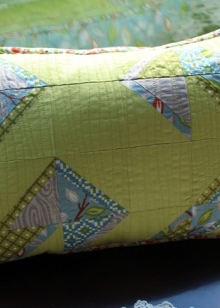
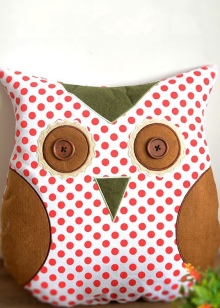
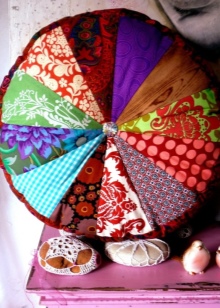
Today, various embellishments of patchwork pillows are in fashion, making flat patterns textured. It can be stitching in the form of simple or curly stitches on one, two sides, with fixing the flap allowance or between two fragments. In addition to laconic strokes, the addition of decorative braid, buttons, lace, sequins is popular. An interesting idea for the design of decorative pillows is the use of satin ribbons, various bows, individual asymmetric frills, ruffles, and embroidery.

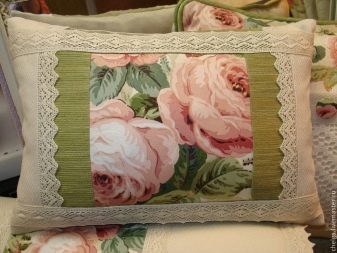
Those who do not have the patience to assemble a piece from miniature scraps enjoy the tricky applique technique using textile and non-woven materials. Usually, such products are made quite simply and do not require adjusting the fragments of the pattern: it is created by means of a zigzag stitch along the edge of the flaps, sewn onto the base.
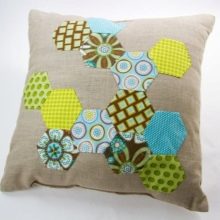
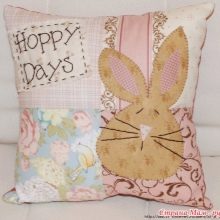
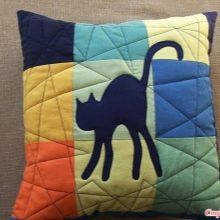
If the edge of the appliqué material does not fray, it is sewn with a needle-forward seam. Due to the textured hand stitching in a contrasting color, such models look beautiful.
Some craftswomen manage to combine the seemingly incompatible: textiles and yarn. However, this is a rather delicate work: the choice of yarn is carried out thoroughly so as not to overload the overall look. The model can consist of a central square and four differently patterned faces.
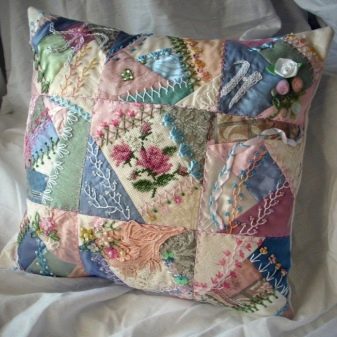

When making such products, a small number of fragments are used.
For how to sew a patchwork pillowcase, see the next video.













The comment was sent successfully.